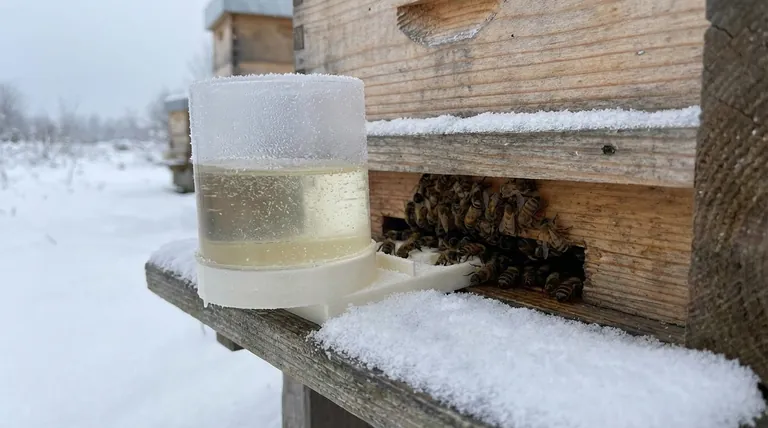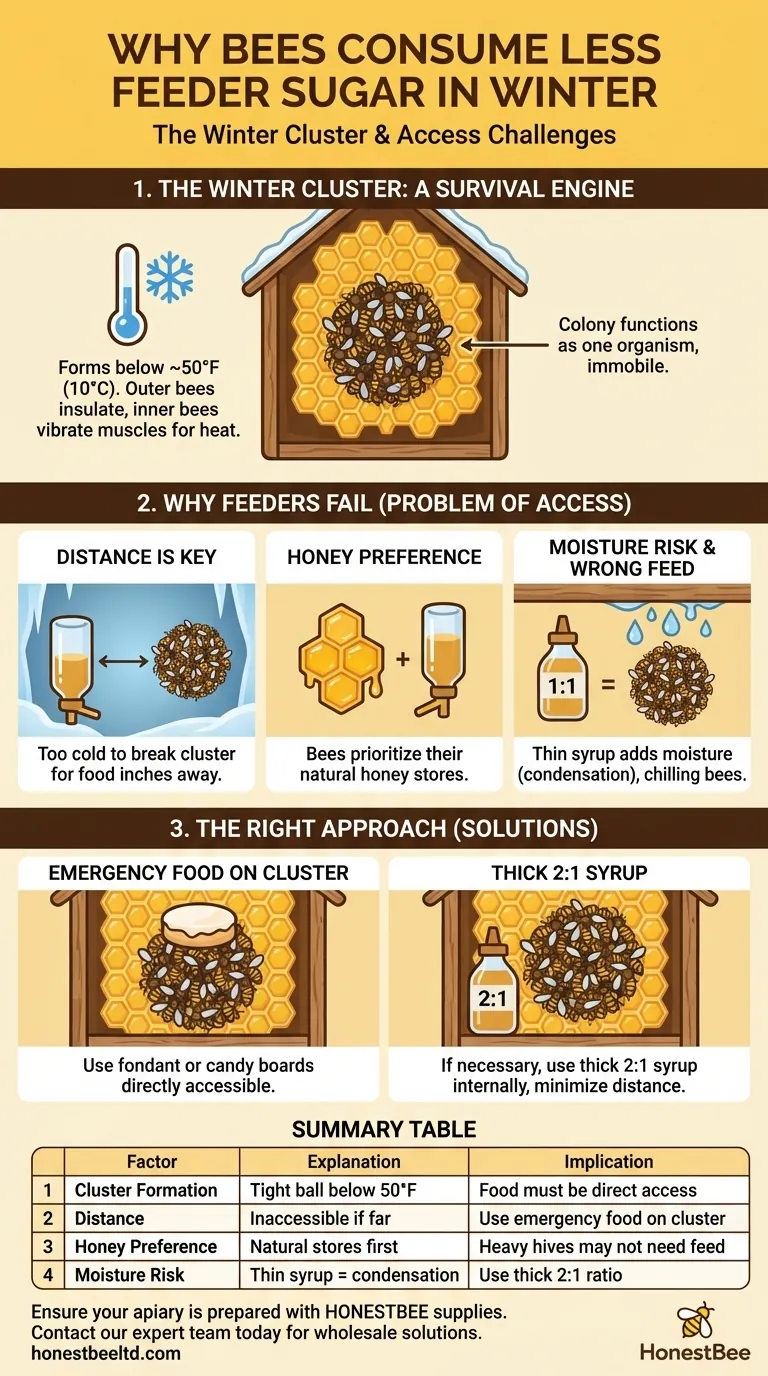In short, bees consume less sugar from feeders in the winter because they are in a tight cluster for warmth. Once temperatures drop below approximately 50°F (10°C), individual bees will not break from this huddle to travel to a food source, as the risk of freezing is too high. Their world shrinks to the size of their cluster, and any food must be directly within their reach.
The core issue is not a lack of hunger, but a problem of access and energy conservation. A bee colony can starve to death just inches away from a feeder if cold temperatures prevent them from breaking their survival cluster to reach it.

The Winter Cluster: A Survival Engine
To understand why bees ignore your winter feeder, you must first understand their primary survival strategy: the winter cluster. This behavior dictates everything they do during the cold months.
What is the Winter Cluster?
A honeybee colony survives freezing temperatures by forming a tight ball of bees around their queen.
Bees on the outer layer of the cluster insulate the group, while bees in the interior generate heat by vibrating their powerful wing muscles. This collective effort keeps the center of the cluster at a stable, warm temperature, even when it is well below freezing outside.
The Critical Role of Temperature
The formation of the cluster is a direct response to ambient temperature. As the air in the hive cools to around 50-57°F (10-14°C), the bees begin to draw together.
The colder it gets, the tighter the cluster becomes. In this state, the colony functions as a single organism focused on one goal: generating heat to survive. Individual activity, like foraging for food from a feeder, ceases entirely.
How the Cluster Moves for Food
The fuel for this heat generation is the honey the bees stored during the warmer months.
The cluster is not stationary; it moves very slowly as a unit throughout the hive, consuming the honey stores it comes into contact with. They will always consume their own honey first before considering any supplementary feed you provide.
Why Your Feeder Is Being Ignored
If a hive has sufficient honey and the temperature is low, bees have both little need and no ability to access a feeder. Several factors are at play.
The Problem of Distance
This is the most common reason. An entrance feeder or even a top feeder that is separated from the cluster by a few inches of cold air is effectively on another planet.
A single bee cannot leave the thermal safety of the cluster to retrieve syrup and make it back. The energy cost and risk of freezing are too great.
A Preference for Honey
Bees will always prefer to eat their own honey over sugar syrup. Honey is their perfect, natural food source.
They will only turn to a sugar feeder if their internal honey stores have been depleted or are inaccessible to the cluster's current position. If your hive still feels heavy, it's likely they are simply consuming their preferred food.
The Wrong Type of Feed
Winter feeding requires a very thick sugar syrup, typically a 2:1 ratio of sugar to water.
Thin syrup (1:1 ratio) can be detrimental in winter. It has a lower freezing point and introduces excess moisture into the hive, which can lead to condensation and chilling the bees—a greater threat than the cold itself.
Understanding the Trade-offs of Winter Feeding
Emergency winter feeding is sometimes necessary, but it is not without risks. It should be seen as a last resort, not a routine practice.
The Danger of Added Moisture
As noted, feeding thin syrup can dramatically increase the humidity inside the hive. When this warm, moist air hits a cold inner cover or wall, it condenses into water droplets.
This "rain" can drip down onto the cluster, chilling and killing the bees. Dryness is just as important as warmth for winter survival.
The Need for Cleansing Flights
Bees do not defecate inside the hive. They wait for a warm day (typically above 50°F / 10°C) to take short "cleansing flights."
Feeding stimulates consumption and digestion, increasing the bees' need to relieve themselves. If a long, cold spell prevents cleansing flights, it can lead to dysentery within the hive, stressing the colony.
Is Feeding Truly Necessary?
The best winter food is the honey the bees made themselves. The primary goal of a beekeeper should be to ensure the hive goes into winter with sufficient stores.
Feeding should only be considered an emergency measure if you have determined the hive is light on stores and in danger of starvation.
Making the Right Choice for Your Hive
Your decision to act should be based on a clear assessment of the hive's condition.
- If your hive feels heavy and bees are not taking feed: This is normal. The colony is warm in its cluster and consuming its own honey stores as intended.
- If your hive feels dangerously light and bees are not taking feed: The food is too far from the cluster. You must provide an emergency food source directly on top of or adjacent to the cluster, such as a fondant patty, candy board, or frame of honey.
- If you absolutely must feed liquid syrup: Use a thick 2:1 mix and place it in an internal feeder as close to the cluster as possible, minimizing the distance the bees must travel.
Understanding your bees' biology is the most powerful tool you have for helping them survive the winter.
Summary Table:
| Key Factor | Explanation | Implication for Beekeepers |
|---|---|---|
| Winter Cluster Formation | Bees form a tight ball for warmth below 50°F (10°C) and cannot break away. | Food must be directly accessible to the cluster, not at a distance. |
| Distance to Feeder | A feeder just inches away is inaccessible if it requires leaving the cluster. | Use emergency food sources like fondant patties placed directly on the cluster. |
| Preference for Honey | Bees will consume their own stored honey before turning to sugar syrup. | A heavy hive likely has sufficient stores; feeding may not be necessary. |
| Risk of Moisture | Thin syrup (1:1 ratio) increases hive humidity, leading to condensation and chilling. | Use a thick 2:1 sugar-to-water syrup ratio for winter feeding to minimize moisture. |
Ensure your apiary is prepared for winter with the right supplies from HONESTBEE.
As a commercial beekeeper or distributor, managing colony health through the winter is critical for your operation's success. HONESTBEE supplies the durable, high-quality beekeeping equipment and winter feeding solutions—like internal feeders and fondant boards—you need to support your hives effectively. Our wholesale-focused operations are designed to meet the demands of large-scale apiaries.
Don't let winter losses impact your bottom line. Contact our expert team today to discuss your specific needs and secure the reliable supplies your business depends on.
Visual Guide

Related Products
- HONESTBEE Entrance Bee Feeder Professional Hive Nutrition Solution for Beekeeping
- HONESTBEE Professional Entrance Bee Feeder Hive Nutrition Solution
- HONESTBEE Professional Hive Top Bee Feeder Feeding Solution
- HONESTBEE Entrance Bee Feeder Efficient Hive Front Liquid Feeding Solution for Beekeeping
- Rapid Bee Feeder White Plastic 2L Round Top Feeder for 8 or 10-Frame Bee Hives
People Also Ask
- What is the best feeder for bees? Choose the Right Feeder for Your Hive's Success
- What are the different types of honey bee feeders? Choose the Right Feeder for Your Hive
- How do you make an entrance feeder for bees? A Guide to Safe & Effective Hive Feeding
- What is a common problem with hive front feeders? Avoid Robbing Frenzies and Protect Your Hives
- Are entrance feeders good for bees? Prioritize Hive Health Over Convenience



















